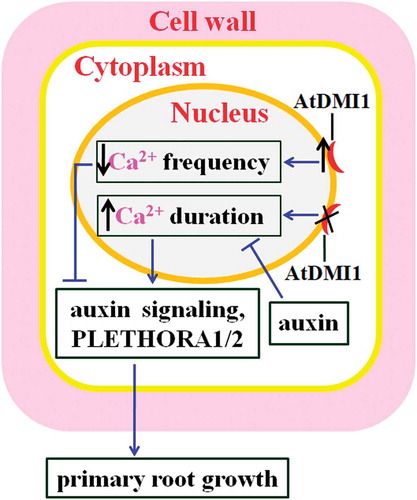Figures & data
Figure 1. Mechanisms for nuclear Ca2+ regulating PR growth. Overexpression of AtDMI1 decreases Ca2+ frequency, inhibiting auxin signaling, decreasing the expression of PLETHORA1 and PLETHORA2, and retarding PR growth. Impairment of AtDMI1 increases Ca2+ duration, stimulating auxin signaling and the expression of PLETHORA1 and PLETHORA2, and PR growth. Thick up and down arrows, respectively, represent increases and decreases in their levels; thin arrows indicate positive regulation, and bars indicate negative regulation. The black cross means impairment of AtDMI1.

Figure 2. Mechansims for cytosolic Ca2+ modulating PR growth. Cytosolic Ca2+ signalings regulate and mediate the signalings of auxin, CTK, BR, ABA, ET, and Cd and salt stress to affect PR development. Ca2+ regulates CBL4/5 and CIPK25, influencing auxin transport and response, and promoting PR growth. CTK inhibits CIPK25, dampening PR elongation. Ca2+ elevations regulated by CNGC2 and AtrbohD/F suppress PR growth. ABA activates CPK4/6, further promotes ET biosynthesis, inhibiting PR growth. ABA activates MPK6, leading to the reduction of ROS and Ca2+ levels and shortened roots. CMI1- and AtGLR3.6-impacted increases of Ca2+ facilitate PR growth. FER-modulated Ca2+ inhibits salt-caused damage of cell-wall integrity, and positively impacts root growth. Ca2+-activated CML38 antagonizes AtRALF1, which interferes with BR signaling, modulating PR elongation. Ca2+ attenuates Cd stress-induced disorder of auxin signaling, facilitating PR growth. Different auxinic compounds like IAA, IBA, NAA and 2,4-D elicit distinct Ca2+ signalings, favoring PR development. Arrows show positive regulation, and bars indicate negative regulation. The dashed line means uncharacterized regulation. The circle with a cross in it reveals damage of cell-wall integrity.

